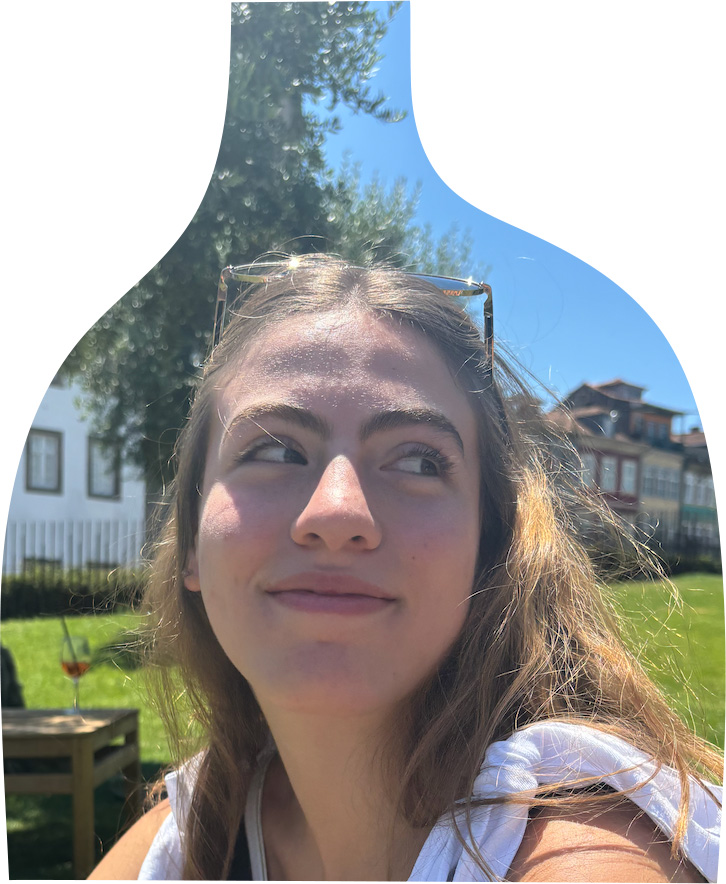
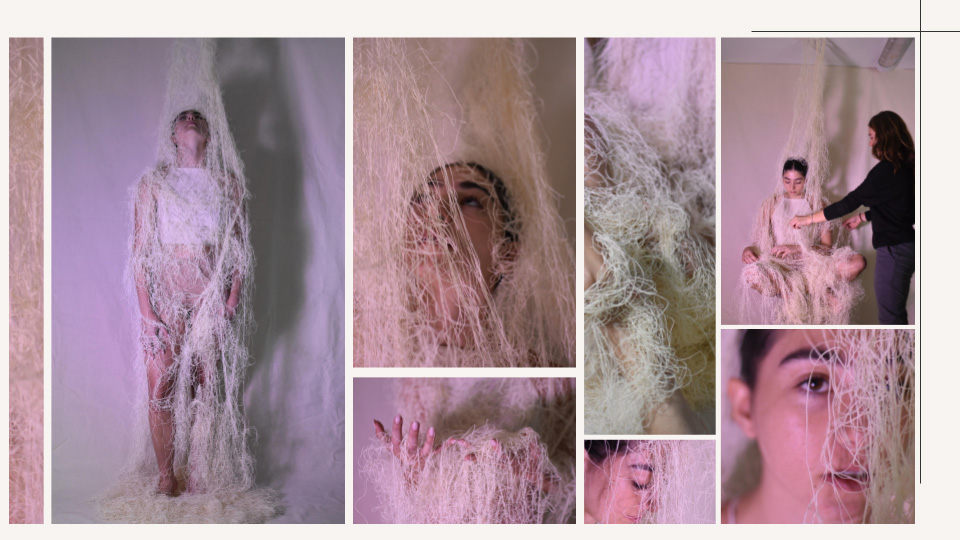

The Unweaving of Time
Height: 90” x Width: 90” x Depth: 40” | Material(s): Canva fabric threads | Process(es): Canva fabric torn apart, leaving the threads that constructed it | Idea(s): My inquiry was inspired by my grandmother's year-long grief and uncertainty during her husband's kidnapping by Colombia's terrorist groups. | Citation(s): Inspired by the myth of Penelope, who unraveled everything she sewed waiting for her husband. | Curatorial Note: Astounding use of 3-dimensional space to synthesize and process such a traumatic event.
Martina LaCouture
Student statement
Student statement
Please describe the context for how the idea for this artwork originated (was this part of your sustained investigation, an independent project, a class assignment, created during a summer study, etc.).
My artwork was inspired by my grandmother's yearlong grief and uncertainty during her husband's kidnapping by Colombia's terrorist groups. I focused on the body as the bearer of the unsettling passage of time and explored her coping mechanisms, such as writing, sewing, and unweaving, to translate these deeply emotional experiences into a collection of haute couture. This context allowed me to use black and white to represent the daily expression of emotions, while red threads and lines symbolized the passage of time, tying the narrative together through both material and concept.
Does your work reference or draw on a contemporary or historical artmaking style, practice, or tradition? If so, please explain.
My work of art references the practice of weaving and unweaving, which is a traditional craft that has been present along the years, being an integral aspect of many cultural and artistic practices.

With the body as the bearer of the unsettling passage of time, I explored a variety of my grandmother's coping mechanisms, such as writing, sewing, and unweaving, using them as a gateway to elaborate a collection of haute couture.
In what ways did you practice and experiment when developing your sustained investigation?
Building on the specific materials I chose to work with during this course, I carefully experimented with diverse techniques to fully explore the potential of my project. The constant act of experimentation and practice led me to use the body as a tool to maximize the expression of what I wove and sewed.
How did you demonstrate revision in your sustained investigation?
During this course, we gradually learned that revision is an artistic way of thinking because it involves being conscious of what you communicate through your work. As I sat down with my teacher every other month to review my portfolio, I became increasingly aware of the storyline I wanted to create and the materials I wanted to use. This process elevated my compositions to a whole new level, allowing me to explore different techniques and forms of expression while always staying true to the idea I wanted to convey.
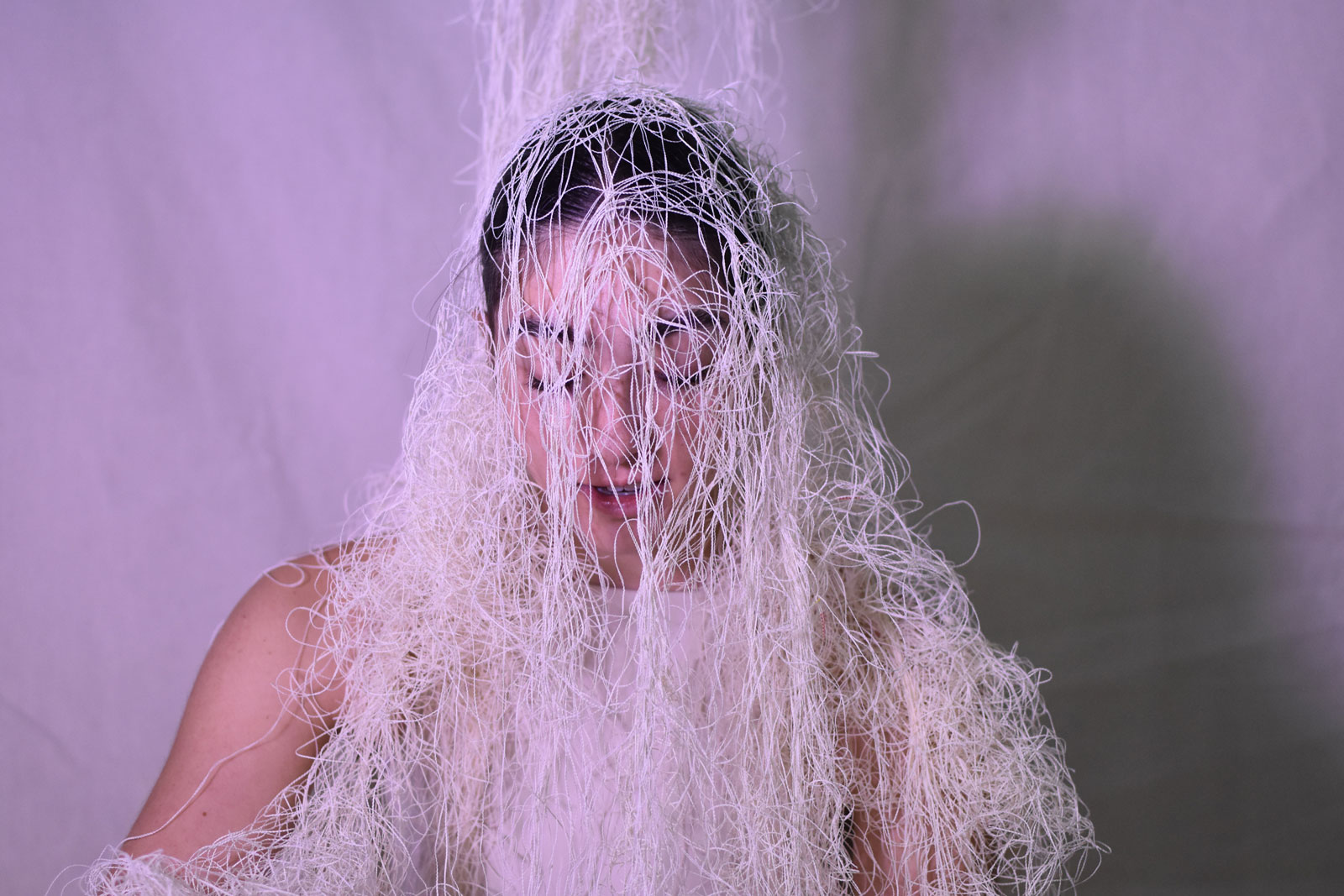
Your work was selected in part because it achieved synthesis. Can you explain your intentionality in choosing materials and developing processes to further your ideas?
Weaving became one of my grandmother's main coping mechanisms, a way to channel the intense emotions she couldn’t express to her children into a constant, repetitive motion. Much like the myth of Penelope, who wove and unwove her loom as she awaited her husband’s return, my grandmother’s act of unweaving her mistakes symbolized both patience and resilience as she faced the uncertainty of her husband's fate. Inspired by these two narratives, I chose to represent a paradox in the art of waiting by unweaving a piece of fabric thread by thread, rather than weaving pieces together. This process, which took over two months, became a part of my daily life, just as it did for these two women before me.
How did your materials and process(es) choices shape the creation or meaning of your artwork(s)?
My choice of materials and processes played a pivotal role in shaping both the creation and meaning of my artwork. Using a large piece of canvas fabric, I carefully removed thread by thread, preserving both the threads and the altered fabric to symbolize the tension between deconstruction and preservation.
How did your art teacher support your artistic development?
I would like to give a special thank you to my teacher, Ms. Lina Sinisterra, who has been a wonderful mentor throughout my artistic journey. Her amazing guidance and passion have shaped my path into the world of art. She taught me to understand the significance of being blocked as an artist and how to use it as an advantage rather than an excuse.
How did your school leadership (principal, assistant principal, guidance counselor, etc.) support your growth as an art student? This could be classroom visits, attending art shows, talking to you about your goals, etc.
I was very fortunate to study at a school that promotes art and creativity. Thanks to this, I had the opportunity to participate in various exhibitions, including the Senior Award Ceremony, which is a very important night for seniors.
What is your advice to other AP Art and Design students?
My advice for students taking this course, or planning to take it, is to embrace bold ideas and stick with them, no matter how crazy they may seem. It’s an amazing feeling to see an idea that once seemed unreachable come to life through your creativity and determination.
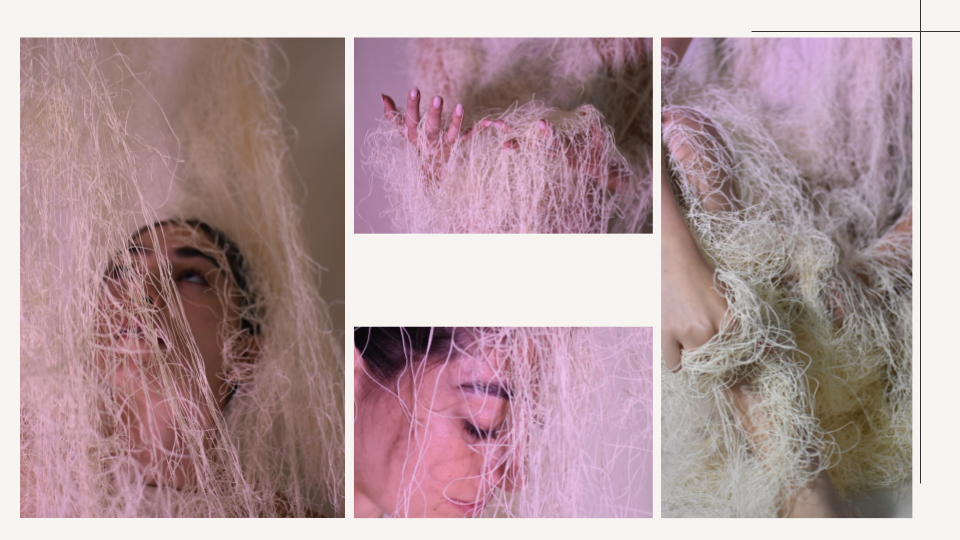
Height: 90” x Width: 90” x Depth: 40” | Material(s): Canva fabric threads | Process(es): Canva fabric torn apart, leaving the threads that constructed it | Idea(s): Tension and pressure mount as dual parental duties overlap over one's shoulders. | Citation(s): Inspired by the myth of Penelope, who unraveled everything she sewed waiting for her husband. | Curatorial Note: Astounding use of 3-dimensional space to synthesize and process such a traumatic event.
Declaración del estudiante
Declaración del estudiante
CASTELLANO
¿Hace su trabajo referencia o se basa en algún estilo, práctica o tradición artística contemporánea o histórica? Si es así, por favor, explique su respuesta.
Mi obra de arte hace referencia a la práctica de tejer y destejer, un oficio tradicional que ha estado presente a lo largo de los años. Esta práctica es un aspecto integral de muchas prácticas culturales y artísticas.
Describa el contexto en el que se originó la idea para esta obra de arte (fue parte de su investigación, un proyecto independiente, un trabajo de clase, creada durante un curso de verano, etc.).
Mi obra de arte se inspiró en el duelo de un año y la incertidumbre de mi abuela durante el secuestro de su esposo por parte de los grupos terroristas en Colombia. Me enfoqué en el cuerpo como portador del inquietante paso del tiempo y exploré sus mecanismos de afrontamiento, como escribir, coser y destejer, para traducir estas experiencias profundamente emocionales en una colección de alta costura. Este contexto me permitió usar el blanco y negro para representar la expresión diaria de las emociones, mientras que los hilos y líneas rojas simbolizaban el paso del tiempo, uniendo la narrativa a través del material y el concepto.
¿De qué maneras practicó y experimentó usted durante el desarrollo de su investigación?
Partiendo de los materiales específicos que elegí trabajar durante este curso, experimenté cuidadosamente con diversas técnicas para explorar plenamente el potencial de mi proyecto. El constante acto de experimentación y práctica me llevó a utilizar el cuerpo como una herramienta para maximizar la expresión de lo que tejí y cosí.
¿Cómo demostró la revisión en su investigación?
Durante este curso, aprendimos con el tiempo que la revisión es una forma artística de pensar porque implica ser consciente de lo que comunicas a través de tu trabajo. Cada vez que me sentaba con mi profesora para revisar mi portafolio, me volvía más consciente de la narrativa que quería crear y los materiales que quería utilizar. Este proceso llevó mis composiciones a un nivel completamente nuevo, permitiéndome explorar diferentes técnicas y formas de expresión, mientras me mantenía fiel a la idea que quería transmitir.
Su trabajo fue seleccionado, en parte, porque logra la síntesis. ¿Puede explicar cuál era su intencionalidad en la elección de materiales y en el desarrollo de procesos para promover sus ideas?
Tejer se convirtió en uno de los principales mecanismos de afrontamiento de mi abuela, una forma de canalizar las intensas emociones que no podía expresar a sus hijos en un movimiento constante y repetitivo. Al igual que en el mito de Penélope, quien tejía y destejería su telar mientras esperaba el regreso de su esposo, el acto de mi abuela de destejer sus errores simbolizaba tanto la paciencia como la resiliencia frente a la incertidumbre del destino de su marido. Inspirándome en estas dos narrativas, elegí representar una paradoja en el arte de esperar, destejiendo una pieza de tela hilo por hilo en lugar de tejer diferentes piezas juntas. Este proceso, que tomó más de dos meses, se convirtió en parte de mi vida diaria, tal como lo fue para estas dos mujeres antes que yo.
¿Cómo influyeron sus elecciones de material(es) y proceso(s) en la creación o el significado de su(s) obra(s) de arte?
La elección de materiales y procesos desempeñó un papel fundamental en la creación y el significado de mi obra de arte. Usando un gran trozo de tela de lienzo, cuidadosamente quité hilo por hilo, preservando tanto los hilos como la tela alterada para simbolizar la tensión entre la desconstrucción y la preservación.
¿Cómo apoyó su profesora su desarrollo artístico?
Me gustaría dar un agradecimiento especial a mi profesora, la Sra. Lina Sinisterra, quien ha sido una mentora maravillosa a lo largo de mi viaje artístico. Su increíble guía y pasión han moldeado mi camino en el mundo del arte. Me enseñó a comprender la importancia de sentirse bloqueado como artista y cómo usarlo como una ventaja en lugar de una excusa.
¿Cómo apoyó la dirección de su escuela (director, subdirector, consejero vocacional, etc.) su crecimiento como estudiante de arte? Este apoyo puede reflejarse a través de visitas a las clases, asistencia a las exposiciones de arte, conversando con usted sobre sus objetivos, etc.
Tuve la gran fortuna de estudiar en una escuela que promueve el arte y la creatividad. Gracias a esto, tuve la oportunidad de participar en varias exposiciones, incluyendo la ceremonia de premios para los seniors, que es una noche muy importante para los estudiantes de último año.
¿Qué consejo daría usted a otros estudiantes de AP Art and Design?
Mi consejo para los estudiantes que están tomando este curso, o que planean tomarlo, es que se atrevan a tener ideas audaces y se mantengan firmes en ellas, sin importar lo locas que puedan parecer. Es una sensación increíble ver cómo una idea que antes parecía inalcanzable cobra vida gracias a tu creatividad y determinación.
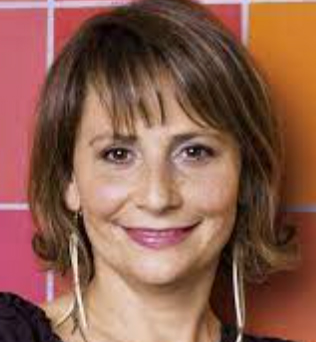
Lina Sinisterra
Colegio Nueva Granada, Bogota, Bogota DC, Colombia
Teacher Statement
Teacher Statement
The AP Art and Design course supports inquiry-based personalized learning in the sustained investigation portfolio component. What strategies helped you guide students through inquiry?
Guiding students through inquiry means fostering a reflective environment where they explore personal themes and uncover the unconscious language in their art. I encourage journaling to identify central themes while observing nonverbal cues like gestures and textures in their work, providing feedback to raise awareness of these expressions. For example, Martina LaCouture’s investigation began with reflections on her grandmother’s grief, evolving through tactile experiments that deepened her emotional insight. This process helps students develop both conceptual understanding and creative expression.
How did you scaffold writing into the art-making and thinking processes?
Writing is the constant flow that drives the creative process in my classroom. Through an evolving "artistic journal," students engage in automatic writing to capture the raw moments of creation, naming and renaming their processes. Rather than focusing on abstract ideas, I encourage them to document tactile experiences and material interactions. For Martina LaCouture, writing about pressing her hands into clay and unraveling fabric revealed the depth of her grandmother’s grief and resilience. This iterative process of writing and making transforms the journal into a bridge between thought and art, where inquiry naturally unfolds.
How did you support skill development AND inquiry in the AP Art and Design curriculum?
I support skill development and inquiry by guiding students to explore materials tied to their writing and inquiry. They create three works with each material, fostering coherence and refining technical skills. Through an evolving “artistic journal,” they document tactile experiences and material interactions, bridging thought and art. Martina LaCouture’s process illustrates this beautifully. She moved from writing to clay, creating writing pieces and dresses inspired by her texts, pressing clay to evoke emotions, and working with yarn and fabric. By unraveling textures, she explored her grandmother’s grief and resilience, where inquiry unfolded naturally.
How did you structure practice, experimentation, and revision into your AP Art and Design curriculum?
Revision is a continuous, personal, and collaborative process in my curriculum. Students constantly self-reflect, revising their work as their ideas and discoveries evolve. Critiques from classmates and the teacher focus on how materials and techniques align with the central concept. This ongoing reflection, driven by creative accidents and shifts, helps refine their inquiry, making it more specific and profound with each iteration.
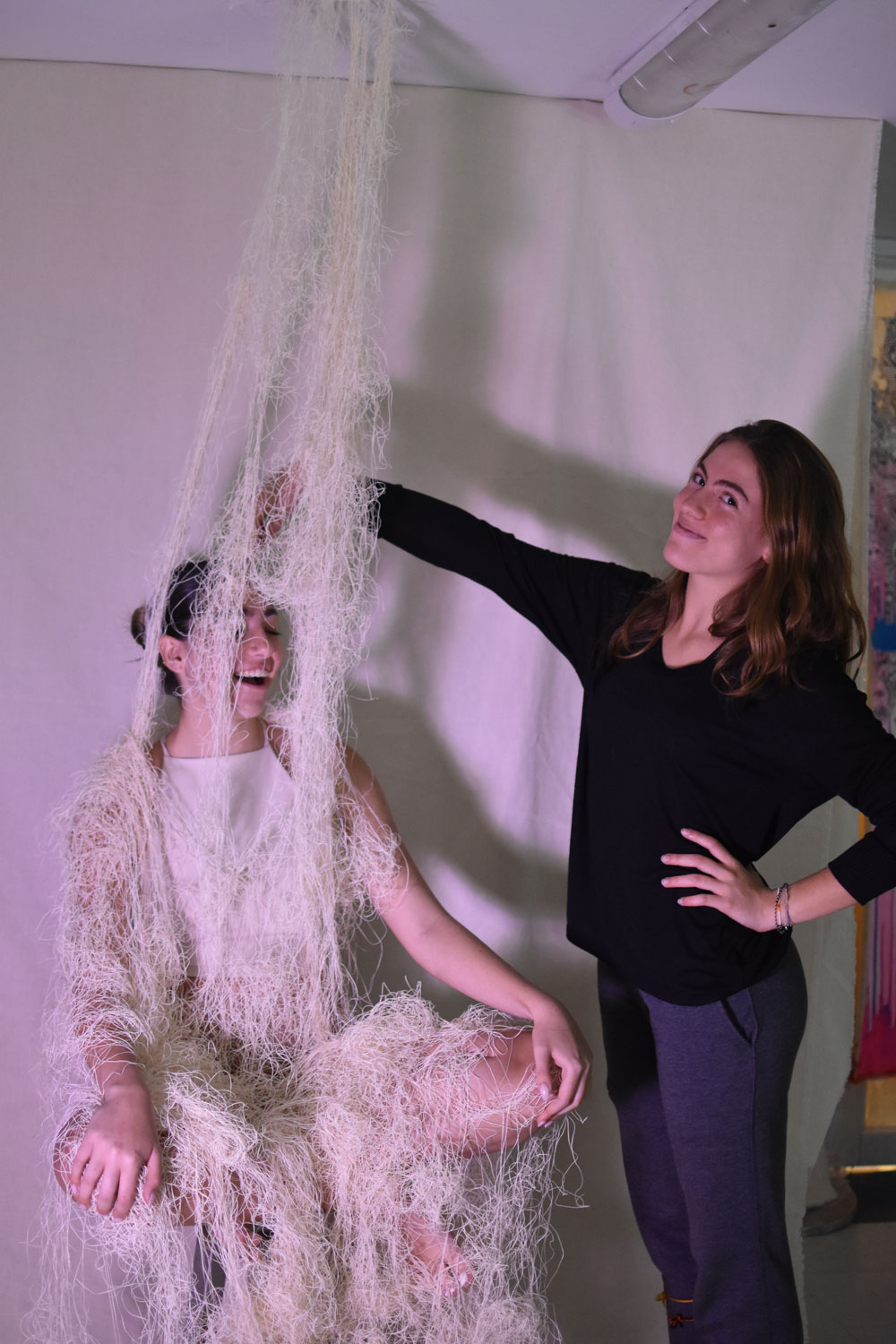
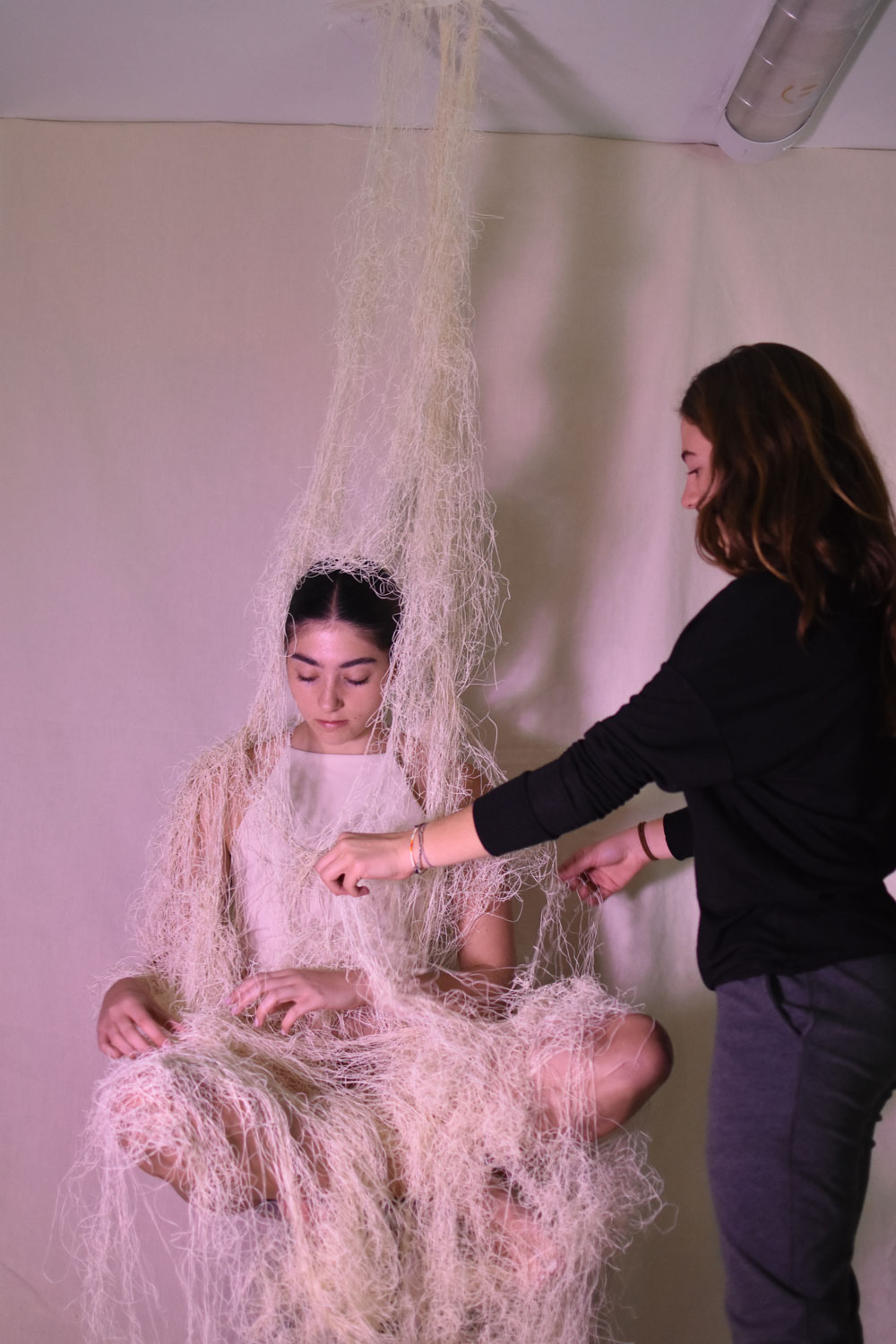
How do you support your students in the Selected Works portfolio component?
Portfolio selection combines personal preference and technical achievement, often reviving discarded pieces. Boldly chosen works unite concept, technique, and composition, showcasing the student’s artistic criteria and creative personal style.
What formative and summative assessments helped guide your students through your AP Art and Design curriculum?
Formative assessments in my AP Art and Design curriculum emphasize constant observation and feedback, focusing on gestures, textures, and sensations that reveal emotions and ideas. Students use evolving artistic journals to document their process, connecting materials to their inquiry through reflective writing and critiques. Summative assessments evaluate how their portfolios unify concepts, techniques, and composition. For instance, Martina LaCouture’s journey from writing and clay to unraveling fabric and creating symbolic dresses exemplifies the seamless integration of exploration and mastery, producing bold, cohesive works that embody her evolving voice.
What creative programming (i.e., exhibit spaces, mentoring programs, curricular supports) have you implemented to support AP Art and Design students?
I support my AP Art and Design students through immersive creative programming. I take them to visit artist studios and the Bogotá Art Fair (Artbo), exposing them to diverse practices and perspectives. I also invite innovative artists to lead workshops, enriching their technical and conceptual skills. A highlight is visiting my studio, where I share my artistic process and demonstrate ways to evolve and connect ideas in art. Students love the experience of seeing an artist's space firsthand, finding inspiration in the environment where creativity flourishes.
What did you learn from working with your student?
Martina's work has taught me the power of vulnerability and the courage to take creative risks. Her exploration of personal themes like grief and resilience reveals how raw moments evolve into powerful expressions. From writing to tactile experiments, her journey shows how vulnerability fuels artistic growth. This year, I've seen how the creative process shapes both the artist and their work. Each student’s journey is a transformative experience, where their art impacts both themselves and the world around them.
Declaración del Profesor
Declaración del Profesor
CASTELLANO
El curso de AP Art and Design apoya el aprendizaje personalizado basado en la exploración en la sección de investigación del portafolio. ¿Qué estrategias le ayudaron a guiar a los estudiantes a través de la investigación/exploración?
Guiar a los estudiantes en la investigación significa fomentar un ambiente reflexivo donde exploren temas personales y descubran el lenguaje inconsciente en su arte. Los animo a escribir para identificar temas centrales, mientras observo pistas no verbales como gestos y texturas, ofreciendo retroalimentación para hacer conscientes estas expresiones. Por ejemplo, la investigación de Martina LaCouture comenzó con reflexiones sobre el duelo de su abuela, evolucionando a través de experimentos táctiles que profundizaron su comprensión emocional. Este proceso ayuda a los estudiantes a desarrollar tanto su comprensión conceptual como su expresión creativa.
¿Cómo incorporó la escritura en los procesos de pensamiento y creación artística?
La escritura es el flujo constante que impulsa el proceso creativo en mi aula. A través de un "diario artístico" en evolución, los estudiantes usan la escritura automática para capturar los momentos crudos de creación, nombrando y renombrandos sus procesos. En lugar de enfocarse en ideas abstractas, los animo a documentar experiencias táctiles e interacciones con materiales. Para Martina LaCouture, escribir sobre presionar sus manos en arcilla y destejer telas reveló la profundidad del duelo y la resiliencia de su abuela. Este proceso iterativo de escribir y crear convierte el diario en un puente entre el pensamiento y el arte, donde la investigación surge de forma natural.
¿Cómo apoyó el desarrollo de habilidades e investigación en el currículo de AP Art and Design?
Apoyo el desarrollo de habilidades y la investigación guiando a los estudiantes a explorar materiales vinculados a su escritura e investigación. Crean tres obras con cada material, fomentando coherencia y perfeccionando habilidades técnicas. A través de un “diario artístico” en evolución, documentan experiencias táctiles e interacciones materiales, uniendo pensamiento y arte. El proceso de Martina LaCouture lo ejemplifica. Pasó de la escritura a la arcilla, creando textos, vestidos inspirados en sus escritos, presionando arcilla para evocar emociones y trabajando con hilo y tela. Al destejer texturas, exploró el duelo y la resiliencia de su abuela, donde la investigación surgió de forma natural.
¿Cómo estructuró la práctica, la experimentación y la revisión en su currículo de AP Art and Design?
La revisión es un proceso continuo, personal y colaborativo en mi currículo. Los estudiantes se auto-reflexionan constantemente, revisando su trabajo a medida que sus ideas y descubrimientos evolucionan. Las críticas de compañeros y docentes se centran en cómo los materiales y técnicas se conectan con la idea central. Esta reflexión continua, impulsada por los accidentes creativos, refina su investigación, volviéndola más específica y profunda con cada iteración.
¿Cómo apoya a sus estudiantes en la sección del portafolio dedicada a las obras seleccionadas?
La selección del portafolio combina la preferencia personal y el logro técnico, rescatando a veces piezas descartadas. Las obras seleccionadas conectan con audacia concepto, técnica y composición, reflejando el criterio artístico y creativo del estudiante.
¿Qué evaluaciones formativas y sumativas ayudaron a guiar a sus estudiantes a través de su currículo de AP Art and Design?
Las evaluaciones formativas en mi currículo se centran en la observación constante y la retroalimentación, destacando gestos, texturas y sensaciones que evocan ideas y emociones. Los estudiantes usan diarios artísticos para conectar materiales con su investigación mediante escritura reflexiva y críticas. Las evaluaciones sumativas miden cómo sus portafolios integran concepto, técnica y composición. Por ejemplo, el recorrido de Martina LaCouture, desde la escritura y la arcilla hasta destejer telas y crear vestidos simbólicos, muestra cómo la exploración y el dominio técnico convergen en obras audaces y cohesionadas.
¿Qué programación creativa (es decir, espacios para exhibiciones, programas de mentoring o tutorías, apoyo curricular) ha implementado usted para apoyar a los estudiantes de AP Art and Design?
Apoyo a mis estudiantes de AP Art and Design con una programación creativa inmersiva. Los llevo a visitar estudios de artistas y la feria de arte de Bogotá (Artbo), exponiéndolos a prácticas y perspectivas diversas. También invito a artistas innovadores a dirigir workshops, enriqueciendo sus habilidades técnicas y conceptuales. Un punto destacado es la visita a mi propio estudio, donde comparto mi proceso artístico y demuestro formas de evolucionar y conectar ideas en el arte. A los estudiantes les encanta la experiencia de conocer de cerca el espacio donde surge la creatividad.
¿Qué aprendió usted al trabajar con su estudiante?
El trabajo de Martina me ha enseñado el poder de la vulnerabilidad y el coraje para asumir riesgos creativos. Su exploración del duelo y la resiliencia muestra cómo los momentos crudos se transforman en expresiones poderosas. Desde la escritura hasta los experimentos táctiles, su viaje demuestra cómo la vulnerabilidad impulsa el crecimiento artístico. Este año, he visto cómo el proceso creativo da forma tanto al artista como a su obra. El viaje de cada estudiante es una experiencia transformadora, donde su arte impacta tanto a ellos como al mundo que los rodea.
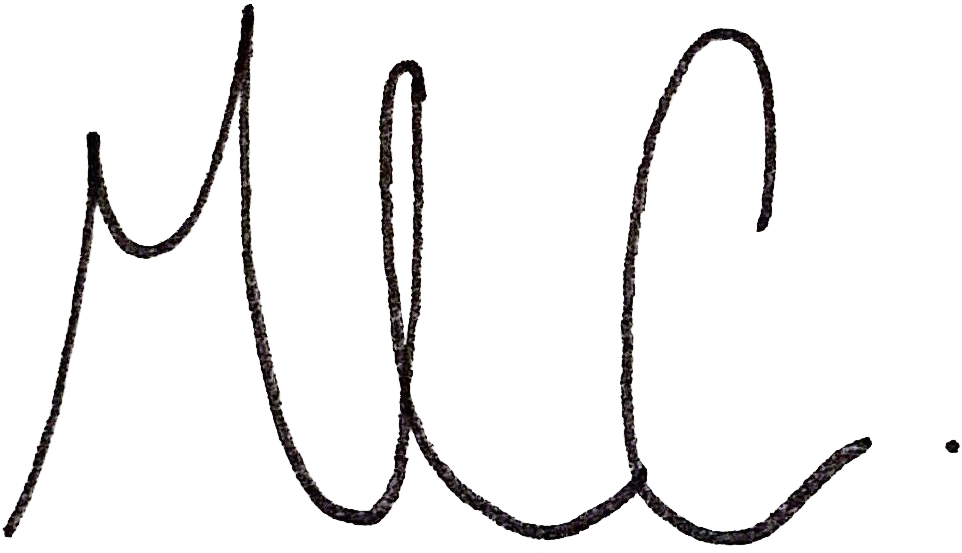
Martina LaCouture

